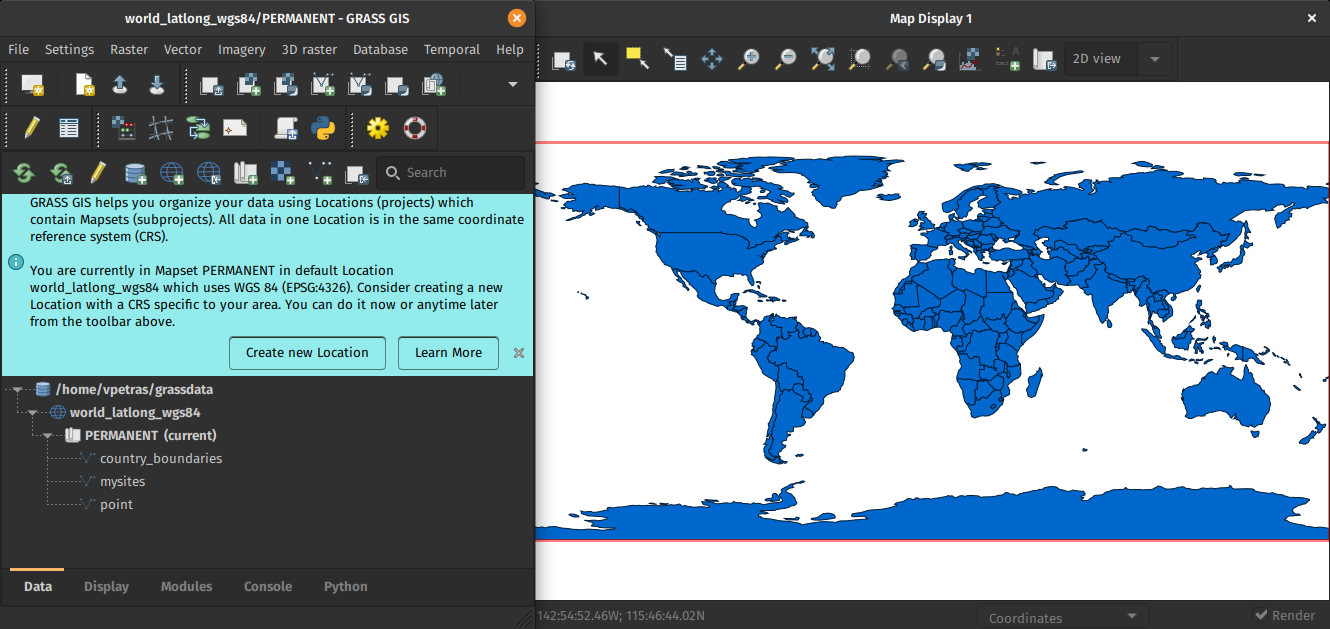| Version 15 (modified by , 3 years ago) ( diff ) |
|---|
List of new features in GRASS GIS 8.0
GRASS GIS 8.0 is actively developed and maintained with a first 8.0.0 stable release in XXX 2021. In total, it comes with almost 1,300 fixes and improvements with respect to the previous stable releases 7.8.x. This page summarizes the manifold new features which have been added to GRASS 8.0.
Table of Contents
What's new in a nutshell
After more than 3 year of development the new stable release GRASS GIS 8.0 is available. Efforts have concentrated on making the user experience even better, providing many new useful additional functionalities to modules and further improving the graphical user interface.
Breaking news: new graphical user interface with entirely rewritten startup sequence!
This re-establishes user experience compatibility with QGIS and other connected software packages.
Lists of new features:
GRASS GIS 8
- provides a completely new first-time user experience
- the improved graphical user interface streamlines how users interact with their data
- dark-themed interface support
- image collection support and semantic labels/band names
- Python 3 scripting
- spatio-temporal data analysis with improved internal data structure
- HPC cluster and cloud support
- semantic label support for all raster maps
Experimental features available as addons now include
- attribute plots
- buffer statistics
- road centerlines
- vector attribute update with Python syntax
- mass-preserving interpolation
- transect generation
- coastal, stream, and dam flooding
- longest flow path
- iterative sub-watershed delineation
- valley flatness
- cost-distance area connectivity
- Sentinel, Landsat, MODIS, USGS, and GBIF data download
- edge detection
- user and producer accuracies
- ... and much more.
Project management: issues, fixes, and ongoing improvements are publicly accessible at GitHub.
Releases
- For more details than on this overview page, see list here:
- The 8.0 release development was officially moved to a dedicated release branch on Nov 13, 2021: https://github.com/OSGeo/grass/tree/releasebranch_8_0
Graphical User Interface
GRASS GIS 8.0 graphical user interface comes with an entirely new concept of startup.
See ... TODO

|
| New first time user startup and dark theme support |
Modules (commands)
A number of relevant improvements have been made (selected list):
General modules
- G80:...
Raster modules
A new class of metadata can now be added to raster maps. We called it semantic labels. Examples of semantic labels are satellite bands, dataset names in remote sensing products, or whatever the user wants to use to identify raster maps. This new feature brings in a series of and advantages. Users can register time series of satellite images and then select which bands or semantic labels to work with, for example, estimate NDVI from a Sentinel 2 time series:
t.rast.mapcalc inputs=test.S2_8,test.S2_4 output=ndvi basename=ndvi expression="float(test.S2_8 - test.S2_4) / (test.S2_8 + test.S2_4)"
The other great advantage is that now the signature files will include these semantic labels, and therefore, signature files of one imagery or raster group can be used to classify a different group with identical semantic labels.
New modules:
- G80:r.semantic.label: manages semantic label information assigned to a single raster map or to a list of raster maps
A number of modules in the raster family received significant modifications. Here the most relevant:
- G80:r.geomorphon: Add geomorphon profiling feature and two zenith/nadir comparison modes. Remove the multires mode, which was broken. Refine documentation and code style.
- G80:...
Vector modules
- G80:...
Imagery modules
All raster classification modules now generate signature files with embedded semantic labels. This allows to apply signature file from one imagery scene to any number of other scenes as long as they consist of same bands (as identified by their semantic labels).
- G80:i.band.library
- G80:...
| New enhanced classification workflow |
Temporal GIS modules
- G80:t.upgrade and G80:t.downgrade
- G80:...
Graphical user interface
- wxGUI ...
Scripting
Major efforts have been taken to port all Python scripts to Python 3.6
Database support
- PostgreSQL driver: ...
Python 3 support
- Code formatting with
black - Hundreds of PEP8 fixes with
flake8
User Manuals - Documentation
Translations
Translations are managed in Transifex (please join and translate messages): https://www.transifex.com/grass-gis/grass7
User manual pages improvements
- numerous user manual pages have received major or minor improvements
- ...
GRASS GIS 8 Library changes
- ...
PROJ support
PROJ 4 to PROJ 7 compatibility implemented.
- ...
GDAL support
GDAL 3 compatibility improved with speed-ups.
Source Code Portability
- Python-3 support implemented across the tree
- FreeBSD: ...
- Mac: ...
- OSGeo4W: ...
Unit tests / CI
- GitHub Actions were activated in the main branch: https://github.com/OSGeo/grass/actions
JSON / REST support
- json parser: ...
Docker support
- ...
GRASS GIS 8.0 Addons
There are numerous new addons which enlarge the already impressive list of addons available (see http://grass.osgeo.org/grass8/manuals/addons/):
- G7A:...
Addons moved to core
These modules have been moved to core GRASS GIS (and removed from addons grass8 branch):
- r.object.geometry
Migrating from GRASS GIS 7 to version 8.x
With the addition of semantic labels, the temporal database was modified to version 3 and hence, to be able to read and process GRASS 7.x space-time datasets, users will be prompted to run G80:t.upgrade. If users want to read newly created space-time datasets in GRASS 7.x, they can run G80:t.downgrade.
Attachments (2)
-
first-time_user_world.png
(230.8 KB
) - added by 3 years ago.
first_time_user
-
band_references_scheme.png
(140.0 KB
) - added by 3 years ago.
band_ref_workflow
Download all attachments as: .zip
